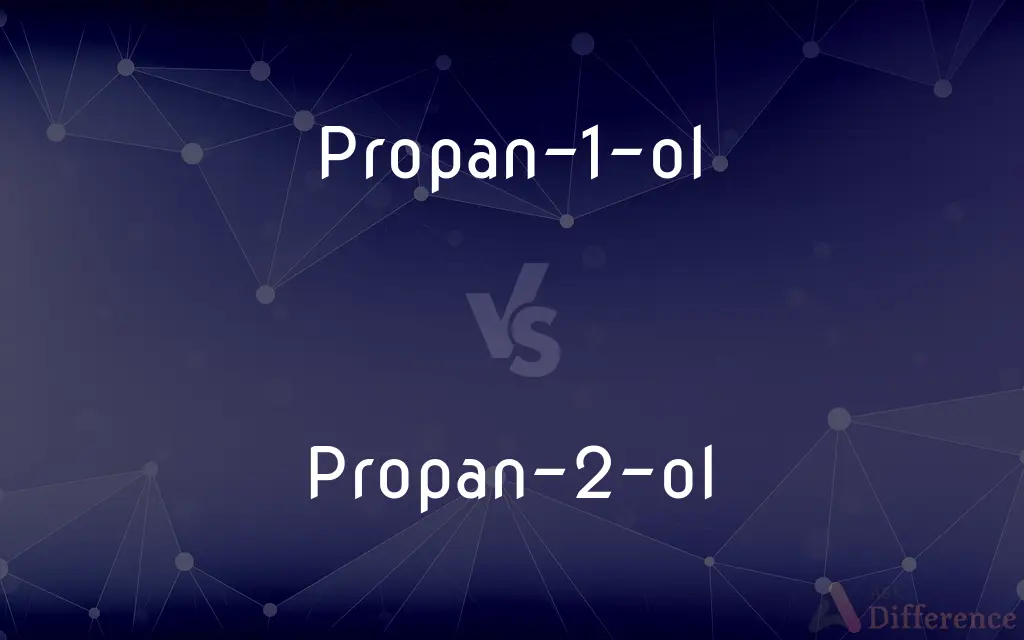Propan-1-ol vs. Propan-2-ol — What's the Difference?
By Tayyaba Rehman — Published on December 31, 2023
Propan-1-ol has the hydroxyl (OH) group attached to the first carbon, while Propan-2-ol has the OH group on the second carbon. Both are isomers of propyl alcohol.

Difference Between Propan-1-ol and Propan-2-ol
Table of Contents
ADVERTISEMENT
Key Differences
Propan-1-ol and Propan-2-ol are two distinct isomers of propyl alcohol. While they share the same molecular formula, C3H8O, the difference between them lies in the placement of the hydroxyl group.
In Propan-1-ol, the hydroxyl (OH) group is bonded to the first carbon atom of the three-carbon chain. This results in a linear structure, making it a primary alcohol. Conversely, in Propan-2-ol, the OH group is attached to the middle, second carbon atom, giving it a more branched structure and categorizing it as a secondary alcohol.
Both Propan-1-ol and Propan-2-ol are used in various industrial applications. However, the difference in their molecular arrangement can impact their reactivity. Propan-1-ol is generally more reactive towards oxidation compared to Propan-2-ol.
The physical properties of Propan-1-ol and Propan-2-ol, like boiling point or solubility, might also vary due to their structural differences. For instance, the boiling point of Propan-1-ol is slightly higher than that of Propan-2-ol.
Although both Propan-1-ol and Propan-2-ol can be found in commercial products and laboratories, it's crucial to distinguish between them, especially when considering specific chemical reactions, as their reactivities and properties can be significantly different.
ADVERTISEMENT
Comparison Chart
Position of OH group
Attached to the first carbon
Attached to the second carbon
Type of Alcohol
Primary
Secondary
Reactivity to Oxidation
Generally more reactive
Less reactive
Boiling Point
Slightly higher
Slightly lower
Common Use
Solvent in industries
Commonly used as rubbing alcohol
Compare with Definitions
Propan-1-ol
Propan-1-ol has its hydroxyl group on the first carbon.
The structure of Propan-1-ol can be represented as CH3CH2CH2OH.
Propan-2-ol
Propan-2-ol has a branched structure.
Its branched form makes Propan-2-ol differ from primary alcohols like Propan-1-ol.
Propan-1-ol
Propan-1-ol is used in the manufacture of various products.
Propan-1-ol can be a solvent in paint formulations.
Propan-2-ol
Propan-2-ol is a secondary alcohol.
Propan-2-ol is frequently used in organic synthesis reactions.
Propan-1-ol
Propan-1-ol is a clear, colorless liquid.
Propan-1-ol is often stored in glass bottles in laboratories.
Propan-2-ol
Propan-2-ol is a volatile liquid.
Propan-2-ol evaporates quickly when exposed to air.
Propan-1-ol
Propan-1-ol is a primary alcohol.
When synthesizing certain chemicals, Propan-1-ol can be an essential reactant.
Propan-2-ol
Propan-2-ol has its hydroxyl group on the second carbon.
The chemical formula for Propan-2-ol can be shown as CH3CHOHCH3.
Propan-1-ol
Propan-1-ol possesses a linear structure.
Due to its linear nature, Propan-1-ol's physical properties differ from branched alcohols.
Propan-2-ol
Propan-2-ol is often used as a disinfectant.
Many households have Propan-2-ol-based rubbing alcohol for first aid.
Common Curiosities
Is Propan-2-ol safe for skin?
Yes, Propan-2-ol is commonly found in rubbing alcohols and disinfectants.
How does Propan-2-ol differ from Propan-1-ol?
Propan-2-ol has the hydroxyl group on the second carbon, making it a secondary alcohol.
Why is Propan-1-ol more reactive towards oxidation?
Being a primary alcohol, Propan-1-ol can be more easily oxidized to an aldehyde than secondary alcohols.
What is Propan-1-ol?
It's a primary alcohol with the hydroxyl group attached to the first carbon atom.
Can I replace Propan-1-ol with Propan-2-ol in reactions?
Not always. Despite being isomers, they can exhibit different reactivities.
Are the physical properties of Propan-1-ol and Propan-2-ol the same?
No, they can differ in aspects like boiling point or solubility due to structural differences.
Is Propan-2-ol used in sanitizers?
Yes, it's a common ingredient in hand sanitizers due to its disinfectant properties.
Are they naturally occurring?
Both can be found in small amounts in nature, especially in fermented products.
Which one is more common in household products?
Propan-2-ol, often found in rubbing alcohols.
Can both Propan-1-ol and Propan-2-ol dissolve oils?
Yes, they can act as solvents for many oils and resins.
Are both flammable?
Yes, both are flammable and should be kept away from open flames.
What is the molecular formula for both?
Both have the formula C3H8O, but their structural arrangements differ.
In which industries is Propan-1-ol commonly used?
It's used in the manufacturing of resins, plastics, and as a solvent in various industries.
Can I use Propan-2-ol to clean wounds?
Yes, it's a common component in disinfectants due to its antiseptic properties.
How are Propan-1-ol and Propan-2-ol produced commercially?
They can be produced through the hydration of propene or via fermentation processes.
Share Your Discovery

Previous Comparison
Home Screen vs. Wallpaper
Next Comparison
Class-I Preservative vs. Class-II PreservativeAuthor Spotlight
Written by
Tayyaba RehmanTayyaba Rehman is a distinguished writer, currently serving as a primary contributor to askdifference.com. As a researcher in semantics and etymology, Tayyaba's passion for the complexity of languages and their distinctions has found a perfect home on the platform. Tayyaba delves into the intricacies of language, distinguishing between commonly confused words and phrases, thereby providing clarity for readers worldwide.














































